
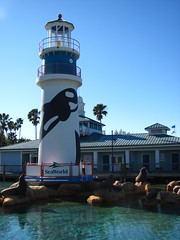 “No matter how much we scorn it, kitsch is an integral part of the human condition.” This quote from Czech author Milan Kundera fairly well summarizes my relationship to theme parks in general. Whether I like to admit it or not, theme parks are rarely anything other than complete kitsch. Yet, loath though I might be from that revelation, every year I willfully pilgrimage to a number of theme parks, permanently piqued by some indescribable appeal these pleasure places have over me. What is “kitsch”, anyway? Kitsch might be defined by some as cheap and/or derivative art, although I prefer to identify it by its function: kitsch is a work of art that, when you encounter it, you are automatically conditioned to know how you are supposed to feel and respond to it. Nobody cries over bad art, but many people will shed a tear in the presence of great kitsch. However, perhaps it was Kundera who provided the best explanation, as applied to theme parks as well as the larger political world he was concerned with, when he wrote that “kitsch is the inability to admit that shit exists”. There’s nothing inherently wrong with kitsch, and I think it’s perfectly fine to seek enjoyment of kitsch so long as we acknowledge it for what it is. Some people dedicate their lives to creating kitsch.
“No matter how much we scorn it, kitsch is an integral part of the human condition.” This quote from Czech author Milan Kundera fairly well summarizes my relationship to theme parks in general. Whether I like to admit it or not, theme parks are rarely anything other than complete kitsch. Yet, loath though I might be from that revelation, every year I willfully pilgrimage to a number of theme parks, permanently piqued by some indescribable appeal these pleasure places have over me. What is “kitsch”, anyway? Kitsch might be defined by some as cheap and/or derivative art, although I prefer to identify it by its function: kitsch is a work of art that, when you encounter it, you are automatically conditioned to know how you are supposed to feel and respond to it. Nobody cries over bad art, but many people will shed a tear in the presence of great kitsch. However, perhaps it was Kundera who provided the best explanation, as applied to theme parks as well as the larger political world he was concerned with, when he wrote that “kitsch is the inability to admit that shit exists”. There’s nothing inherently wrong with kitsch, and I think it’s perfectly fine to seek enjoyment of kitsch so long as we acknowledge it for what it is. Some people dedicate their lives to creating kitsch. Other people will even give up their lives in the name of defending their country’s kitsch. Some kitsch can be awesome to witness, but most of it isn’t. What is universal about kitsch is that we can’t escape from it. Understanding kitsch is necessary to understand what it means to be human.
Other people will even give up their lives in the name of defending their country’s kitsch. Some kitsch can be awesome to witness, but most of it isn’t. What is universal about kitsch is that we can’t escape from it. Understanding kitsch is necessary to understand what it means to be human.
Where I get uncomfortable is when animals become the subjects of kitsch. Kitsch requires culture, culture requires language, and language requires memetic replicators, which function very differently in animals than humans, if the species is capable of even basic memetic replication at all. By the very nature of how the mind operates, the subjective experience of any animal is virtually unknowable to humans, as our experience is unknowable to them. (For the initiated I highly recommend a glance at Thomas Nagel’s philosophical essay “What is it like to be a bat?”) The concepts, values, and aesthetic content of kitsch are all presumably nonsense to animals, yet they can easily be made by humans to appear to ‘endorse’ our kitsch through simple strategic framing and manipulation. Kitsch always wants to transcend itself, to be more than just cheap emotional entertainment and become the aesthetic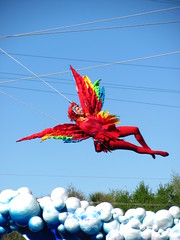 rule of law for all of humanity, and one of the best ways to achieve that is to make it appear as if its message is part of the order of the natural world. Even if nobly intended, it represents just another way in which humans assert dominion over nature: meaningfully rather than physically. Kitsch is one of those cultural factors that can make life so confused for humans, and I think part of the reason that certain people feel a special kinship with animals is because there’s a sense that, whatever the cognitive or emotional differences between us and them, animals are always genuine.
rule of law for all of humanity, and one of the best ways to achieve that is to make it appear as if its message is part of the order of the natural world. Even if nobly intended, it represents just another way in which humans assert dominion over nature: meaningfully rather than physically. Kitsch is one of those cultural factors that can make life so confused for humans, and I think part of the reason that certain people feel a special kinship with animals is because there’s a sense that, whatever the cognitive or emotional differences between us and them, animals are always genuine.
SeaWorld Orlando is kitschy. They sincerely want you to believe that their magnificent story of wonder and imagination about the oceans and all of nature’s children is the most mesmerizing and inspiring thing you’ll ever witness outside of your most spectacular dreams! SeaWorld has an unhealthy affinity for big adjectives and abstract nouns, a telltale signal of some of the worst kinds of kitsch. If they actually wanted us to engage with all their vague but grandiose messages about the wonder of nature and the importance of conversation then we’d be wading into some interesting philosophical territory (Aristotle even gets a quote inside the Shark Encounter, of all places), but the ubiquitous mood lighting, ambient soundtracks, and tasteful decorations always draw our conclusions for us as to exactly what it is we’re supposed to think and feel about nature, and usually that conclusion is very sentimental.
philosophical territory (Aristotle even gets a quote inside the Shark Encounter, of all places), but the ubiquitous mood lighting, ambient soundtracks, and tasteful decorations always draw our conclusions for us as to exactly what it is we’re supposed to think and feel about nature, and usually that conclusion is very sentimental.
From the moment I walked in I was greeted with swelling, heroic orchestral music, and after a couple hours I discovered that this music never goes away. It will follow you throughout most of the midways, queues for major attractions, and of course in the majority of the shows. Okay, so I’m supposed to feel empowered and elated. The themed environments are all pleasant but non-descript and very pastel, calling to mind Greek, Spanish, or Caribbean influences as they might be used by the master planners of an upscale Floridian seniors community. So I’m also supposed to feel relaxed and harmonious. And then there’s also the abstract art designs, ethereal lighting, and impressionistic soundscapes that permeate the enclosed environments in the park (at least wherever the orchestral music isn’t present). Okay, so I also have a sense of mystery and wonder stacked on top of all those other feelings I’m supposed be having at SeaWorld. The perpetually underlined emotional manipulation can become so heavy-handed and omnipresent that a minute of understated but intricate flamenco guitar by the lakefront became a huge relief that art is not yet completely dead, at least in Orlando.
those other feelings I’m supposed be having at SeaWorld. The perpetually underlined emotional manipulation can become so heavy-handed and omnipresent that a minute of understated but intricate flamenco guitar by the lakefront became a huge relief that art is not yet completely dead, at least in Orlando.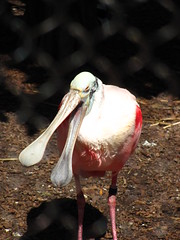
As a zoological park I expected I might be spending a lot of my time watching fish in tanks and learning about how gills filter oxygen or some such so I could forget it all the next day. Maybe SeaWorld once was the big outdoor aquarium with a few educational shows and rides I had in mind going in, but today it oddly seems to neglect the zoological aspects in favor of being a very different kind of park. It’s honestly quite difficult to find a fish in SeaWorld that can be appreciated without all the kitschy show elements intruding to tell me exactly how I can become one with this fish by touching it with accompanying mood music or some shit like that. Regardless of what they say,
elements intruding to tell me exactly how I can become one with this fish by touching it with accompanying mood music or some shit like that. Regardless of what they say, SeaWorld is first, foremost, and by a wide margin, a theme park. One that has progressively become the treacly sentimental caricature of theme parks that critics often overestimate Disney to be… and it’s a strategy that seems to be garnering terrific profits, so more power to them. SeaWorld Orlando is kitsch with some commendable conservation goals and a great many employees who sincerely care for their animals and educating the general public about them, but it kitsch nonetheless.1
SeaWorld is first, foremost, and by a wide margin, a theme park. One that has progressively become the treacly sentimental caricature of theme parks that critics often overestimate Disney to be… and it’s a strategy that seems to be garnering terrific profits, so more power to them. SeaWorld Orlando is kitsch with some commendable conservation goals and a great many employees who sincerely care for their animals and educating the general public about them, but it kitsch nonetheless.1
Manta
As of this writing manta rays can be found in only four public aquariums worldwide, none of which belong to the SeaWorld chain. With that (inconvenient) fact out of the way, I can get to the good stuff. At first I was afraid that Manta would behave as nothing more than an oversized Superman: Ultimate Flight clone, with a couple extra barrel rolls and an unnecessary midcourse block brake added to mess up the pacing rhythms. Although I think the layout comparison is still largely appropriate, Manta succeeds in a lot of the ways the generic flying coaster layout it’s based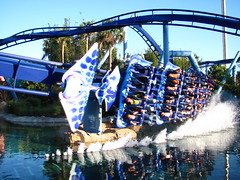 upon fails. The first half, always keeping us several stories above the ground (except for when we’re flat on our backs), does a decent enough job at emphasizing the feeling of flight that’s the genre’s forte. The post-midcourse brake section ran the risk of redundancy, but SeaWorld’s creative design team smartly avoided this by substituting acrophobic aerobatics with the introducing the ‘near-miss’ water interactions (that also make for a decent vista from the entry midway) that refresh the experience as unpredictable and engaging until a few moments from the very end. I’m still a bit uneasy about the placement of the pretzel loop at the very beginning of the layout – it’s such a showstopper that everything afterward always pales by the immediate comparison, and gentle, airy flying sensations are hard enough to sell thrill seekers on without already
upon fails. The first half, always keeping us several stories above the ground (except for when we’re flat on our backs), does a decent enough job at emphasizing the feeling of flight that’s the genre’s forte. The post-midcourse brake section ran the risk of redundancy, but SeaWorld’s creative design team smartly avoided this by substituting acrophobic aerobatics with the introducing the ‘near-miss’ water interactions (that also make for a decent vista from the entry midway) that refresh the experience as unpredictable and engaging until a few moments from the very end. I’m still a bit uneasy about the placement of the pretzel loop at the very beginning of the layout – it’s such a showstopper that everything afterward always pales by the immediate comparison, and gentle, airy flying sensations are hard enough to sell thrill seekers on without already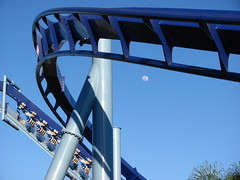 being upstaged from the start – but understandably it’s the signature move for the B&M flying coaster, and lacking any uneven terrain (it’s Florida, after all) I’d much rather have this element as big and powerful as possible even if it comes at the expense of the sequence that follows. Some folks of weaker dispositions might disagree, but people don’t visit SeaWorld to have a relaxed, feel-good time, we’re here for the lung-crushing intensity… right…?
being upstaged from the start – but understandably it’s the signature move for the B&M flying coaster, and lacking any uneven terrain (it’s Florida, after all) I’d much rather have this element as big and powerful as possible even if it comes at the expense of the sequence that follows. Some folks of weaker dispositions might disagree, but people don’t visit SeaWorld to have a relaxed, feel-good time, we’re here for the lung-crushing intensity… right…?
Grade: B
Blue Horizons (Whale and Dolphin Stadium)
Dolphins doing tricks for fish isn’t anything new,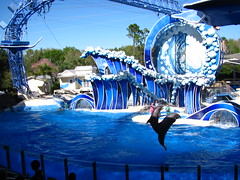 but it can also be educational for us and I’m sure the dolphins get some needed stimulus. Instead, in Blue Horizons it’s the audience that ends up getting over-stimulated. Birds, divers, acrobats, ridiculous costumes, melodramatic music, something about “love” or “dreams”, and a massive stage originally designed for an oral hygiene product commercial are all thrown together in the confetti mix to ensure that no tourist will even momentarily be distracted by their own thoughts. “Blue Horizons” could be interpreted a couple of different ways: literally, where sky meets the sea; metaphorically, where dreaming meets believing; or truthfully, where pompous but thematically ambiguous pageantry meets an audience jaded by run-of-the-mill dolphin flips. You can try to disentangle the “story” or “message” from the show if you if you absolutely must
but it can also be educational for us and I’m sure the dolphins get some needed stimulus. Instead, in Blue Horizons it’s the audience that ends up getting over-stimulated. Birds, divers, acrobats, ridiculous costumes, melodramatic music, something about “love” or “dreams”, and a massive stage originally designed for an oral hygiene product commercial are all thrown together in the confetti mix to ensure that no tourist will even momentarily be distracted by their own thoughts. “Blue Horizons” could be interpreted a couple of different ways: literally, where sky meets the sea; metaphorically, where dreaming meets believing; or truthfully, where pompous but thematically ambiguous pageantry meets an audience jaded by run-of-the-mill dolphin flips. You can try to disentangle the “story” or “message” from the show if you if you absolutely must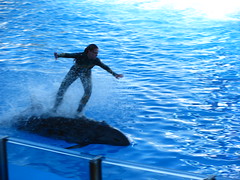 find something meaningful in it all, but then you’d be missing the point. Blue Horizons is intentionally nonsensical so that we’ll quickly learn to turn off our rational cognitive processes and instead we can rapturously bliss-out in our seats and experience emotions that we would normally guard against. It’s an effective aesthetic technique used by a great many pop artists, if only SeaWorld could give those feelings a wider range than sentimental hippy happiness, and direct them at something purposeful afterward rather than let the emotion float aimlessly inside our head like a cloud of cannabis smoke. Without that direction all that’s left is a spectacle of conscripted animal labor designed to make a stadium of first-world tourists momentarily feel happier for no rational reason.
find something meaningful in it all, but then you’d be missing the point. Blue Horizons is intentionally nonsensical so that we’ll quickly learn to turn off our rational cognitive processes and instead we can rapturously bliss-out in our seats and experience emotions that we would normally guard against. It’s an effective aesthetic technique used by a great many pop artists, if only SeaWorld could give those feelings a wider range than sentimental hippy happiness, and direct them at something purposeful afterward rather than let the emotion float aimlessly inside our head like a cloud of cannabis smoke. Without that direction all that’s left is a spectacle of conscripted animal labor designed to make a stadium of first-world tourists momentarily feel happier for no rational reason.
A’Lure, The Call of the Ocean (Nautilus Theater)
More than a decade ago it might have seemed like a strange phenomenon: that the avant-garde Cirque du Soleil troupe would become a major format for themed entertainment that any park wanting to be seen as cutting edge would include in its line-up. This could be optimistically interpreted as a sign that the general public’s artistic palate has expanded in recent years to demand more subtly and emotional depth than the standard pop song and dance revue, although the fact that the term “Cirque” now refers to a generic brand of entertainment makes me think that the truth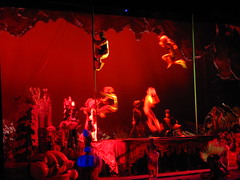 is a little more sociologically complex. As a Cirque-style show (whatever that’s supposed to mean anymore) SeaWorld’s “A’Lure, The Call of the Ocean” is visually and aurally dense, yet conceptually and emotionally very lightweight. As long as the psychedelic stimuli doesn’t stop and people in crazy costumes continue dancing or flying around the room, we’re going to be too dazzled to care if the blunt transitions delineating the “energetic”, “scary”, and “happy/ romantic” numbers add up to anything aesthetically coherent by the end. I’d be a heartless bastard if I condemn this as bad art, so instead let’s celebrate it as a great work of kitsch.
is a little more sociologically complex. As a Cirque-style show (whatever that’s supposed to mean anymore) SeaWorld’s “A’Lure, The Call of the Ocean” is visually and aurally dense, yet conceptually and emotionally very lightweight. As long as the psychedelic stimuli doesn’t stop and people in crazy costumes continue dancing or flying around the room, we’re going to be too dazzled to care if the blunt transitions delineating the “energetic”, “scary”, and “happy/ romantic” numbers add up to anything aesthetically coherent by the end. I’d be a heartless bastard if I condemn this as bad art, so instead let’s celebrate it as a great work of kitsch.
Grade: C-
I believe this is currently the only major aquarium on SeaWorld’s property that isn’t also a decoration for a gift shop or ride queue, nor requires its residents to perform tricks for spectators every hour or so. The Shark Encounter’s main claim to fame is a 124 foot long walk-through tube running through a massive tank filled with sharks and other fish, and it’s certainly an incredible way to spend three minutes before reaching the end of the people mover. More species can be viewed (or even touched) in smaller tanks at your leisure, although as the park’s sole standalone aquarium there’s probably not much that you haven’t encountered before.
Sky Tower
There’s a lot to like about this 1974-built observation tower. It stands an even 400 feet tall, offers terrific views of the entire park, has an attractive coastal loading deck, and as of 2012 is now included free with park admission. Beware, that last item can be a double edged sword. Its iconic profile makes it one of SeaWorld’s most popular attractions while simultaneously having one of the lowest capacities, so just because you’re not paying with cash doesn’t mean you won’t ultimately pay just as much if not more with your time in line.
Shamu Express
Good news: there’s no maximum height limitation or “must be accompanied by a child” rules, so coaster counters are free to credit away! Bad news: it’s really popular with the kids, a demographic in abundance at SeaWorld, so there’s no sneaking a ride in while few people are looking. Better news: at first glance the Zierer made coaster appears big enough that you might think you won’t have to feel too awkward about riding it alone! Worst news: it doesn’t matter, for you shall feel very awkward anyway.
Journey to Atlantis
Kitsch isn’t good for you, but if you understand the associated health risks than deep-fried kitsch can be delicious nonetheless. What I’m trying to say is: this dark-flume-coaster ride is a ton of some dumb fun. If archeologists ever discover the lost city of Atlantis they better have their UV lights on hand because if SeaWorld did their research correctly then the ancient Atlantean hieroglyphs and pictograms are all going to be in bright neon fluorescent paint. It’s a very long, complex ride, with multiple lulls and highlights that culminate in two separate climatic splashdowns, and a fairly detailed storyline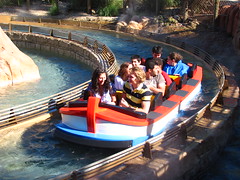 that follows alongside the action. But while the exterior’s classically ornate palace might suggest a grand Greek drama, the interior plays more like a cheesy 1970’s made-for-TV adventure movie. Meet characters such as an evil siren in a Halloween costume (imaginatively named “Allura”), a caricature of a Greek fisherman that’s nearly SNL quality level racism, or the anthropomorphic sidekick seahorse that periodically pops up to do jack all. Translate this into the most expensive and technologically advanced carnival spook house you can possibly imagine and the result, for better or worse, is Journey to Atlantis. Good in exactly the right places and “so-bad-its-good” in all the rest, I only wish the roller coaster finale could have made a bigger impact and then it might have been one of the better flume rides in the country.
that follows alongside the action. But while the exterior’s classically ornate palace might suggest a grand Greek drama, the interior plays more like a cheesy 1970’s made-for-TV adventure movie. Meet characters such as an evil siren in a Halloween costume (imaginatively named “Allura”), a caricature of a Greek fisherman that’s nearly SNL quality level racism, or the anthropomorphic sidekick seahorse that periodically pops up to do jack all. Translate this into the most expensive and technologically advanced carnival spook house you can possibly imagine and the result, for better or worse, is Journey to Atlantis. Good in exactly the right places and “so-bad-its-good” in all the rest, I only wish the roller coaster finale could have made a bigger impact and then it might have been one of the better flume rides in the country.
Grade: C+
Kraken
This coaster is an easy target for criticism since it took the basic formula for B&M looping coasters (perfected at sister park Busch Gardens Tampa) and did extremely little to improve on it or make it its own. The first half is Kumba, the second half is Montu, the sum is bigger and longer than both, and yet somehow Kraken is equal to less of a good coaster than either of its mythological parents. Particular weaknesses include an unattractive gravel and concrete setting under the majority of the layout, a vertical loop set in an unfinished tunnel left uncovered with exposed sheet metal walls, and a conclusion that starts with some promise but then tapers off with a flat runway to the brakes before the rising action was resolved. What’s the point of a cobra roll if it only wastes track afterward to turn us 180° back in the direction we were originally headed? Also, it should be noted that the underground tunnel before the corkscrew smells like a former inhabitant of the Shark Encounter died in there. Despite this list of complaints that I could go
parents. Particular weaknesses include an unattractive gravel and concrete setting under the majority of the layout, a vertical loop set in an unfinished tunnel left uncovered with exposed sheet metal walls, and a conclusion that starts with some promise but then tapers off with a flat runway to the brakes before the rising action was resolved. What’s the point of a cobra roll if it only wastes track afterward to turn us 180° back in the direction we were originally headed? Also, it should be noted that the underground tunnel before the corkscrew smells like a former inhabitant of the Shark Encounter died in there. Despite this list of complaints that I could go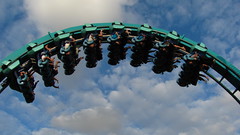 further on, Kraken somehow found a way to make me like it, begrudging though I might be. It’s smooth and has some massive loops and drops. The floorless configuration is a huge plus to have in the front row, and if you don’t feel like waiting that long the last row has a couple nice pops of airtime on the straight first drop and the midcourse brake plunge that are better than what you can find on its relatives in Tampa. As long as the queue is short and fast there’s no reason to ask for anything better… although that’s not always the case.2
further on, Kraken somehow found a way to make me like it, begrudging though I might be. It’s smooth and has some massive loops and drops. The floorless configuration is a huge plus to have in the front row, and if you don’t feel like waiting that long the last row has a couple nice pops of airtime on the straight first drop and the midcourse brake plunge that are better than what you can find on its relatives in Tampa. As long as the queue is short and fast there’s no reason to ask for anything better… although that’s not always the case.2
One Ocean (Shamu Stadium)
As the biggest cookie in SeaWorld’s roundup of animal entertainment featuring the park’s signature killer whales, One Ocean thankfully dials back on the kitsch. Unlike Blue Horizons, the focus of One Ocean is more about the marine life and less about the ego of the artistic director. Four moving video screens form the backdrop and the accompanying music is more about rhythms to which you can tap your rolled up map on your lap, instead of soaring symphonic arrangements about finding true love in a cetacean that are orchestrated to reduce us to a quivering mess of schmaltz. From my understanding this represents a vast improvement over the show’s previous incarnation “Believe”, which I’m almost sorry I missed if only because I like to end a review set with some good zingers. One Ocean is still not a radical change from the others, as the show again only serves to get us to a generalized emotional state of “happy” (or “wet and happy”) that supports a vaguely defined message about the oneness of humans and the oceans or something like that. Contrary to the park’s claims this is not an educational show. Occasionally the announcer will mention the importance of ecological conservation, but never were we educated on the specifics of why conservation is important or what we can do to help. We’re given instructions to visit a website to learn more (www.seaworldcares.com), which I suspect
mess of schmaltz. From my understanding this represents a vast improvement over the show’s previous incarnation “Believe”, which I’m almost sorry I missed if only because I like to end a review set with some good zingers. One Ocean is still not a radical change from the others, as the show again only serves to get us to a generalized emotional state of “happy” (or “wet and happy”) that supports a vaguely defined message about the oneness of humans and the oceans or something like that. Contrary to the park’s claims this is not an educational show. Occasionally the announcer will mention the importance of ecological conservation, but never were we educated on the specifics of why conservation is important or what we can do to help. We’re given instructions to visit a website to learn more (www.seaworldcares.com), which I suspect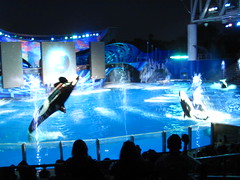 less than 1% of audience members actually visit, and those that do would only realize it’s only to self-promote SeaWorld’s corporate social responsibility initiatives. This meant the last question on my mind as we filed out the exit was: Why as a society do we need to be entertained by killer whales jumping in the air for fish before we will even listen to a message not to throw plastic bottles in the water?
less than 1% of audience members actually visit, and those that do would only realize it’s only to self-promote SeaWorld’s corporate social responsibility initiatives. This meant the last question on my mind as we filed out the exit was: Why as a society do we need to be entertained by killer whales jumping in the air for fish before we will even listen to a message not to throw plastic bottles in the water?
Grade: C
Summary
Maybe one day the animal rights activists will win the debate and we’ll all look back on our time and money spent in support of the SeaWorld parks with the same quiet regret we hold from several other dark chapters in American history. Even if that day never comes, this sentiment might be felt for a few different reasons. One of those reasons won’t be the roller coasters, however, since at least SeaWorld might hold the overall best collection in a single park in the Orlando area, even if only by a slim margin.
in support of the SeaWorld parks with the same quiet regret we hold from several other dark chapters in American history. Even if that day never comes, this sentiment might be felt for a few different reasons. One of those reasons won’t be the roller coasters, however, since at least SeaWorld might hold the overall best collection in a single park in the Orlando area, even if only by a slim margin.
Overall Grade: D+
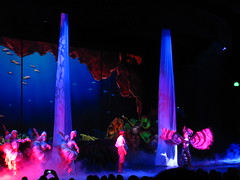
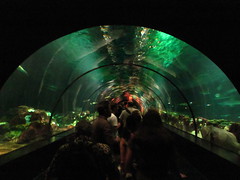


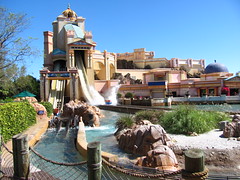
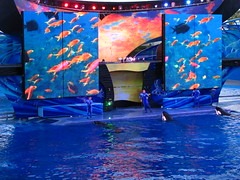
Footnotes & Annotations
[1] For whatever reason SeaWorld was much more crowded than any of the other parks we visited in early March, even though we went on a weekday. For that reason it was the one park in which I missed out on a couple semi-major attractions. The sea lion comedy show was already filled to capacity we arrived for our intended performance time and an alternate time just never worked out, while the Wild Arctic attraction and animal exhibit was my fault we skipped; I thought it was permanently closed to become part of the Antarctica project, but it was the Penguin Encounter I had mistaken it for, so as a result we never made it over there. I think I also missed the manatee exhibit as a result. SeaWorld has one of the most confusing infrastructures I’ve ever seen in a major American theme park, not aided by all the construction projects going on. Maybe next time when I can check everything off my list I’ll have a warmer impression of the place.
[2] The bigger crowds were most felt on Kraken, which for whatever reason was one train operation the entire time we were there, not quite enough to handle demand and the line slowly backed up further and further throughout the day. Late in the afternoon the crew had a minor technical issue requiring them to call in the mechanics, and they decided to use the opportunity to add the second train to the tracks to finally relieve congestion. The process took them awhile to complete, and once finished they were only able to get one dispatch sent out (on the original train) before they had another more serious issue with the second train (the new one). More tinkering and tests were performed, and the situation was finally resolved with the decision to put the second train back in the transfer shed and reduce Kraken to one train operation (again). By the time it was running regularly once more the long queue had taken care of itself, as everyone in the park had simply given up on Kraken and left the area to find something better to do. Problem solved! Stay classy, SeaWorld.
We discussed the animal shows at Sea World before. I mean, I get why they are popular. I will admit to being quite impressed with them technically. And honestly, a whale jumping in the air in front of you is pretty difficult to deny being effective in terms of wow’ing someone. That said, performing animals still suck and it is a testament to how far we really have come as a civilization that they’re still seen as being a necessary and indispensable tool of education (edutainment?).
Also, screw haters. Kraken is fun. It is a big smooth roller coaster with some good negative G’s and impressively sized elements. Theme wise it is “meh” but so that is with any multi-inversion coaster over 150 ft.
Can we really fault the similarities between Kraken/Montu/Kumba when these are both Busch parks and the same manufacturer? To me, it seemed like the best possible looper design considering what BG-Tampa and IOA have in-stock. It could be worse, like Seaworld San Antonio’s Batman clone with Six Flags nearby.
I think a big fluffy HyperCoaster near the water would target this place’s audience very well and stand out when compared to other Florida parks.
Am I surprised by the similarities between Kraken and Kumba & Montu? No. Makes all the sense in the world. The issue as I see it is that Kraken supposedly should have had an advantage over those two installation, taking the best features of both and also being taller, faster, and longer than either one. Yet very few people would rate Kraken as the best ride out of the three. Florida is overstuffed with B&M coasters, and while I wouldn’t say Kraken is the worst, I would say that it’s the most forgettable or easy to overlook (especially relative to its size) when I consider the reasons I’d like to go back to the Florida parks.
Actually, your second point reminds me of something else I made note of at SeaWorld that I forgot to comment on in the review. It does seem odd that the SeaWorld chain of parks, when they decided to add steel coasters to their parks, mostly went with big, intimidating, multi-looping steel monsters. Apart from the JTA water coasters, it took until 2012 for one of their parks to add a mid-sized family thrill coaster (San Diego’s Manta, which was probably as much a product of local zoning restrictions as SeaWorld’s own decisions), when you would have thought given their product it would have been the opposite way around. Start with the mid-level, everyone-can-enjoy coasters like San Diego’s Manta, and maybe only later up the ante with bigger Busch Gardens style thrill rides. Of course I personally don’t mind this strategy at all, since Manta/Kraken/Journey are probably my favorite threesome of coasters at any Orlando park (I think a little bit more the IOA’s B&M designs, at least now that they’re not dueling the dragons any more) but it still makes for a slightly uneven product lineup.
I think Shamu’s gonna bring in the kids and old people no matter what. The challenge is appealing to a different demographic that whales and dolphins do not in and of themselves reach. Therein lies the need for thrill machines.
“Why as a society do we need to be entertained by killer whales jumping in the air for fish before we will even listen to a message not to throw plastic bottles in the water?”
Both the great thing about your reviews Jeremy, and simultaneously the problem with them, is that you are considerably more intelligent than the average theme park visitor, better educated, and furthermore educated in an area that is pretty specialised. Your understanding of philosophy creates a unique filter though which you view the world, and whilst I love it precisely for its intelligence, which is a refreshing change on theme park sites, it does mean that sometimes I feel you judge places by criteria that are a little unfair…
In answer to your question quoted above, sadly yes society’s average IQ is so low that unless we feed it mindless entertainment there’s no chance of it following up with the sort of intellectual leap and association that you (and I hope most of your readers on this site) would do… If the USA is anything like the UK then public debate occurs at a sort of sub-X-Factor level and if a performing Whale manages to make even 1% of the population consider marine conservation in more depth then frankly I think it’s worth it. I kind of wish it wasn’t so but we have to live in the world as it is, not as we’d like it to be.
I also think you can be a bit harsh on some of the attractions – in the terms you apply to review then your scores are fair and your comments just, (and I would have to agree with them), but the vast majority of visitors won’t be applying your criteria to their experience and they will enjoy it on a different level. At that level I actually think Seaworld is one of the more successful parks. It’s beautiful, emotive, (yes kitsch), and original but I find myself able to simply ‘go with the flow’ there and I have to say I really enjoy the place.
The whole ethical issue to do with ‘performing’ animals however is another crate of spiders entirely….
Alan, I get that point, it’s just a bit strange that they chose a completely dichotomous approach as you noted rather than a smoother continuum of kids and family stuff and thrill stuff. Holiday World is the only other park that has as strong of a divide between audiences, although Busch Gardens (especially Williamsburg) was that way as well especially during the gap between BBW and Verbolten.
David, thanks for the feedback on my writing. You’re probably right that I can be unrealistically critical at times, but one of the larger agendas I’ve had for a while is that theme parks have been lagging behind other divisions of cultural entertainment (film, music, literature, etc), probably for some specific systematic reasons, and I’d rather fight the impulse to lower expectations and just become an “enthusiast” whereby I’m automatically more predisposed to enjoy the medium than someone who’s more skeptic of its merits would be. There are a small handful of parks and attractions that I do feel deserve a solid “A” grade at least by my criterion, and I don’t wish to water the impact of those reviews down by giving too much praise to everything else I come across as okay. I also have no interest in writing reviews that are merely ‘predictors’ of how much I think the average park-goer is likely to enjoy a given attraction themselves, and instead use the review format to explore issues that I think are interesting to me that perhaps not everyone has considered.
Jeremy – don’t change the way you review, or your criteria – that wasn’t my point. There are any number of theme park websites that offer ‘populist’ reviews. The reason we come to this site is precisely for that difference. I guess I just wanted to make the point that so long as we all bear in mind that we are discussing parks at a level that in reality doesn’t need to be attained, (however desirable it might be), we can occasionally just step back and say – ‘well it could be a lot better but you know what, it’s still a lot of fun’.
I’m off to Orlando in two week’s time and I expect to enjoy every park we visit, (all 9 of them). I know there’s so much more they could be, but it won’t stop me having a blast. Intellectual analysis is one thing but it’s hard to convince my heart and emotions that something could be better when they are just going ‘”Woo-hoo” with a silly grin on their faces…. 🙂
Well, I don’t think any of this analysis should be considered divorced from the immediate emotional response. True it might be going through more filters and in consideration of more factors than an average visitor, but at the end of the day it’s about how much I personally liked or enjoyed something, and then I try to reverse engineer the experience to figure out exactly why I reached that opinion. It sounds more like we probably have slightly different reactions to SeaWorld, because there were definitely many times when I had no such silly grin on my face. The second paragraph, about when kitsch tries to ‘taint’ the natural world, is just something that’s never sat well with me at a very basic level, and I intended to make that topic more central in the reviews but somehow I didn’t.
I suppose I visit parks with the assumption already loaded into my mind that they are going to be kitsch or false or unceasingly in-my-face happy and I guess I apply some sort of filter subconsciously that stops it annoying me. As such what I see at Seaworld is one of the more physically attractive parks that happens to offer me quite a few ‘wow’ moments. I know there’s a debate about whether or not we should be using animals to perform ‘behaviours’ but regardless of that argument I find the Shamu show, for example, profoundly moving. Whether it will move me as much this time now that the trainers are not allowed in the water I don’t know but the partnership of man/woman and whale not only astonished me but spoke to me somewhere very deep inside about how close we actually could get to the animal world… Ironic that I saw partnership whereas the animal rights people see slavery. And I know which makes for the better theme park experience…